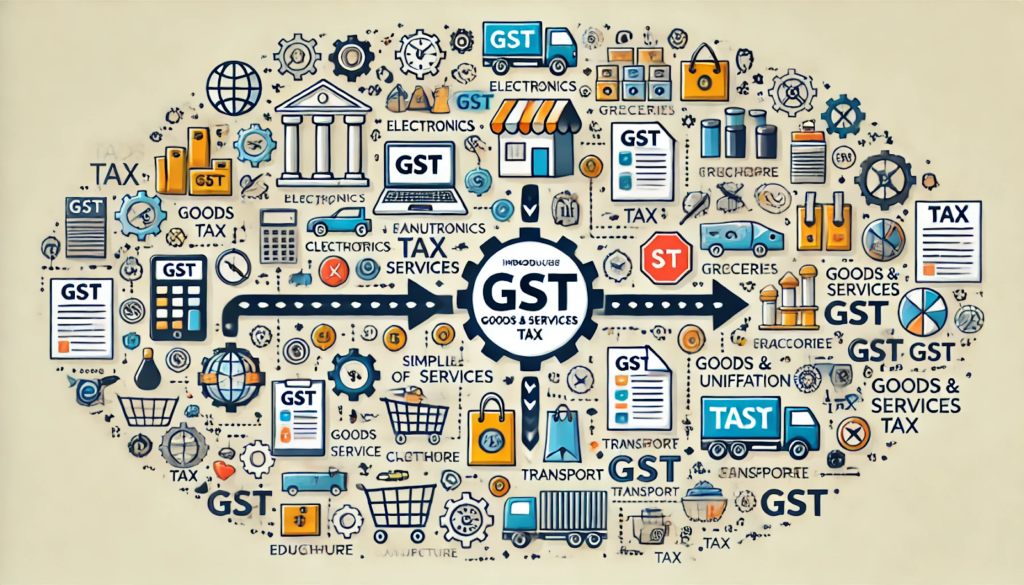The Goods and Services Tax, sometimes known as the GST, is a tax that was recently added to the Indian tax system and is assessed on the delivery of goods and services. GST Registration is necessary for the proper operation of the firm. It takes about 3-6 working days to obtain GST Registration. Any company that operates without GST is breaking the law and faces consequences. The central government would collect the CGST or SGST based on the transaction under the GST statute. Both CGST and SGST are collected when a supply of goods or services occurs within the state; this type of transaction is referred to as an intrastate transaction.

What is the Goods & Services Tax?
The Goods and Services Tax (GST) is a comprehensive tax that is levied on the supply of goods and services. It is a dual-level tax system, comprising the Central GST (CGST) and State GST (SGST). It has replaced the multiple taxes previously levied by the Central and State Governments of India.
Some of the biggest benefits of GST for all kinds of industries and businesses have been:
What is the Central Goods and Services Tax (CGST)?
The Indian government imposes the Central Goods and Services Tax on all transactions involving products and services within the state. It is a tax imposed on all transactions that take place within the state. The CGST has taken the place of all previous central taxes, including the central excise charge, service tax, and customs duty. Both taxes are imposed based on the commodities, and the rates for the CGST and SGST are the same.
Illustration: A has to pay two taxes if he wants to sell a product to B, who lives in the same state. The SGST rate will be 9% in addition to the 9% CGST rate. GST is not collected on products consumed in the state in which they are produced. The manufacturing tax levied by the state is then transferred to the consuming state by the union government.
Calculation of CGST
You are a business owner and you charge ₹12,000 for a product. Given that the product’s GST rate is 18%, the total GST comes to ₹2,160 (18% of ₹12,000). Half of the total GST for sales within the state is made up of the CGST and SGST (State GST). Hence, half of ₹2,160, or ₹1,080 (9% of ₹12,000), is the CGST.
What is the State Goods and Services Tax (SGST)?
The state goods and services tax, or SGST for short, is one of two taxes imposed on intrastate sales of goods and services. The state in which the items are bought and sold is subject to SGST. The current state taxes, such as the VAT, sales tax, entertainment tax, luxury tax, entry tax, state cess, and surcharge on any form of transaction involving goods and services, would be replaced by this new one. The only entity that designs the revenue obtained under the SGST is the state government.
Illustration: Goods sold by Arun from Uttar Pradesh to Lakshay from Uttar Pradesh will be subject to 18% GST, which also includes 9% CGST and 9% SGST
Calculation of SGST
Assume you run a bakery in Delhi and you charge a customer in the same state ₹10,000 for a cake. Cake is subject to a 5% GST rate, which comprises both SGST and Central GST (CGST). The SGST rate in this scenario would be 2.5%, or half of the 5% overall GST rate. Thus, in this transaction, you would charge the client ₹250 for SGST, which would be collected by the state government.
What is the difference between CGST and SGST?
| Difference | CGST | GST |
| Meaning | The Central Goods and Service tax under GST has replaced the existing tax services tax, excise tax, etc. | SGST means the state goods and service tax that has replaces the existing tax like the sales tax, luxury tax, etc. This tax is levied by the state government. |
| Collected by | Central Government | State Government |
| Benefiting authorities | Central Government | State Government |
| Applicable on transaction | Intrastate (Within the state) | Intrastate (Within the state) |
| Registration | No registration, until the turnover, is exceeding Rs.20 lakh (For northeastern states it is Rs.10 lakh) | No registration, until the turnover, is exceeding Rs.20 lakh (For northeastern states it is Rs.10 lakh) |
| Composition scheme | The dealer can use the benefits up to Rs.75 lakh under the composition scheme | The dealer can use the benefits up to Rs.75 lakh under the composition scheme |
FAQs
What kind of tax is GST?
The majority of products and services supplied for domestic use are subject to an indirect tax known as the products and Services Tax (GST).
What are the benefits of getting GST registration?
Obtaining GST registration has several advantages, including unrestricted interstate sales and the ability to claim the input tax credit. For small firms, a composition plan is an additional option that offers reduced tax liability, increased working capital, and fewer compliances. The GST tax system has significantly lessened cascading.
